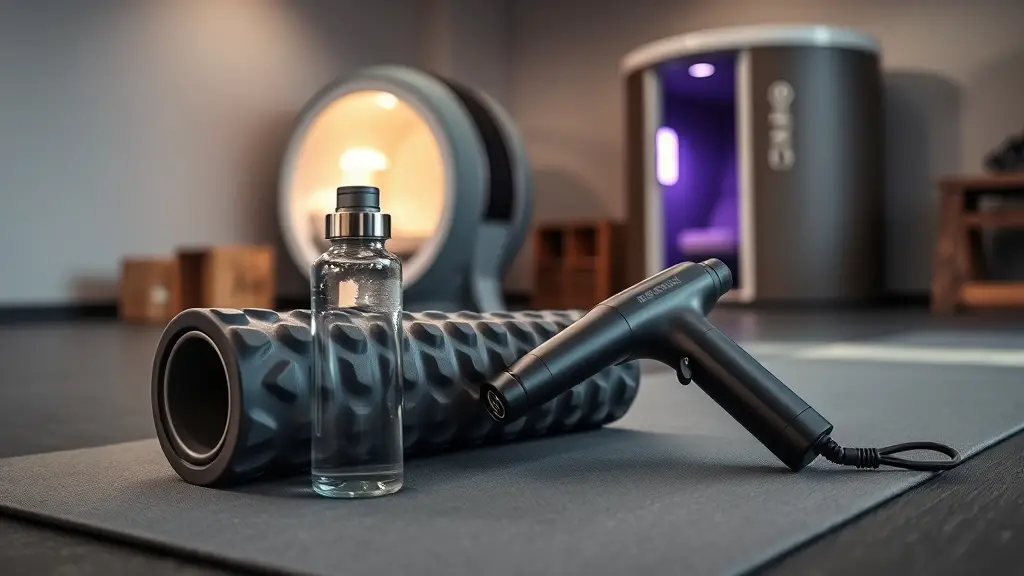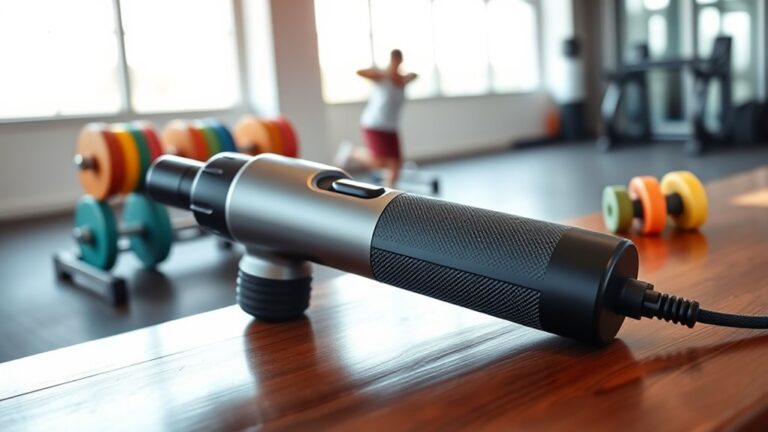The Best CrossFit Recovery Techniques for Long-Term Success

To achieve long-term success in CrossFit, prioritize quality sleep for effective recovery and muscle repair. Aim for 7-9 hours nightly and create a cool, dark environment. Fuel your body with high-quality protein post-workout, hydrate, and include healthy fats and carbs. Incorporate active recovery techniques like walking or yoga to minimize soreness, and don’t forget mobility work to boost flexibility and prevent injuries. Ready to optimize your recovery further? There’s more you can do to enhance your performance.
The Importance of Sleep for Recovery

When you prioritize sleep, you’re not just resting; you’re actively enhancing your recovery process. Quality sleep is essential for muscle repair and overall performance, and it starts with good sleep hygiene. Creating a consistent sleep schedule helps regulate your circadian rhythms, which can improve the quality of your rest. Aim for 7-9 hours per night, and make your sleep environment conducive to relaxation—think cool, dark, and quiet.
Avoid screens before bedtime, as blue light can disrupt your circadian rhythms, making it harder to fall asleep. Instead, establish calming pre-sleep rituals like reading or meditation. Remember, when you get quality sleep, your body produces growth hormone, essential for muscle recovery and growth. By making sleep a priority and following these practical tips, you’ll not only feel more energized but also enhance your CrossFit performance. So, invest in your sleep; it’s a game changer for your recovery journey.
Nutrition Strategies to Support Muscle Repair
To effectively support muscle repair after intense CrossFit sessions, it’s essential to focus on your nutrition. Prioritize protein timing by consuming high-quality protein within 30 minutes post-workout. This helps kickstart muscle recovery and enhances growth, allowing you to bounce back stronger. Aim for about 20-30 grams of protein, incorporating sources like chicken, fish, or plant-based options.
Equally important are hydration strategies. Dehydration can impede recovery, so drink water throughout the day and consider electrolyte-rich drinks after grueling workouts. Staying hydrated helps transport nutrients to your muscles, reducing soreness and fatigue.
Don’t forget healthy fats and complex carbohydrates; they play a vital role in overall recovery. By fueling your body with the right nutrients at the right times, you’ll not only feel better but also improve your performance in future sessions. Stay committed to your nutrition, and you’ll set yourself up for long-term success in CrossFit.
Active Recovery Techniques and Their Benefits

While proper nutrition lays the groundwork for recovery, incorporating active recovery techniques can further enhance your performance and well-being. Active recovery involves engaging in low-intensity activities, like walking, cycling, or yoga, which can help reduce muscle soreness and improve blood circulation. The benefits of active recovery are explained through research showing that it aids in flushing out metabolic waste and delivering nutrients to muscle tissues.
The Role of Mobility and Flexibility Work
Although many athletes focus on strength and conditioning, neglecting mobility and flexibility work can hinder overall performance and recovery. Incorporating mobility exercises and flexibility routines into your training can greatly enhance your range of motion, reduce injury risk, and improve workout efficiency. Here are three practical strategies to enhance your recovery:
- Dynamic Stretching: Before workouts, include mobility exercises that warm up your muscles and joints, preparing your body for high-intensity movements.
- Static Stretching: Post-workout, dedicate time to flexibility routines that help elongate your muscles, promoting relaxation and reducing soreness.
- Foam Rolling: This self-myofascial release technique can alleviate muscle tightness, improve blood flow, and enhance your overall mobility.
Utilizing Recovery Tools and Technology

As you focus on enhancing mobility and flexibility, integrating recovery tools and technology can take your recovery game to the next level. Modern recovery gadgets and tech innovations are designed to optimize your healing process, helping you feel refreshed and ready for your next workout.
Here’s a quick comparison of popular recovery tools:
| Recovery Gadget | Benefits |
|---|---|
| Foam Roller | Improves blood flow, reduces soreness |
| Massage Gun | Targets muscle knots, relieves tension |
| Compression Boots | Enhances circulation, speeds recovery |
| Infrared Therapy Device | Reduces inflammation, promotes healing |
| E-Stim Device | Alleviates pain, enhances muscle recovery |
Incorporating these tools into your routine not only accelerates recovery but also enhances performance. Don’t underestimate the power of technology—embrace it, and you’ll be on your way to long-term CrossFit success!
Frequently Asked Questions
How Often Should I Incorporate Recovery Days Into My Routine?
Think of your body as a finely tuned machine; without proper maintenance, it won’t perform at its best. Incorporating recovery days into your routine is essential for ideal frequency. Aim for at least one to two recovery days per week, allowing your muscles to repair and grow stronger. By scheduling these days strategically, you’ll enhance your performance and prevent burnout. Remember, rest isn’t a luxury; it’s an essential part of your success!
What Are the Signs I Need More Recovery Time?
You might need more recovery time if you notice fatigue indicators like persistent tiredness or a lack of motivation. Muscle soreness that lingers beyond usual discomfort can also signal that your body’s asking for a break. If workouts feel harder than usual or your performance dips, listen to these signs. Prioritizing recovery isn’t just smart; it’s essential for your long-term progress and overall well-being. Remember, rest is part of the journey to improvement!
Can I Still Train While Recovering From an Injury?
Steering through the waters of recovery can feel like walking a tightrope, but you can still train while healing from an injury. By implementing injury modifications, you can maintain your fitness without aggravating your condition. Adjusting your training intensity is important; focus on lighter weights or alternative movements that don’t strain the injured area. It’s vital to listen to your body, as gradual progress can keep you on track for a successful comeback.
How Does Stress Impact My Recovery Process?
Stress can greatly hinder your recovery process. When you’re stressed, your body produces cortisol, which can slow healing and increase inflammation. To combat this, focus on stress management techniques like mindfulness, deep breathing, or yoga. Incorporating these into your recovery strategies can enhance your overall healing. Remember, prioritizing mental well-being is just as important as physical recovery, so don’t underestimate the power of a calm mind in your healing journey.
What Role Does Hydration Play in Recovery?
Hydration acts as fuel for your recovery, quenching your body’s thirst and replenishing lost fluids. It aids in nutrient transport, supports muscle repair, and diminishes fatigue. When you prioritize ideal intake, you’re enhancing your performance and promoting faster recovery. Remember, staying hydrated helps regulate temperature and joint lubrication. So, keep that water bottle close; your body will thank you for every sip you take toward a quicker bounce-back!





